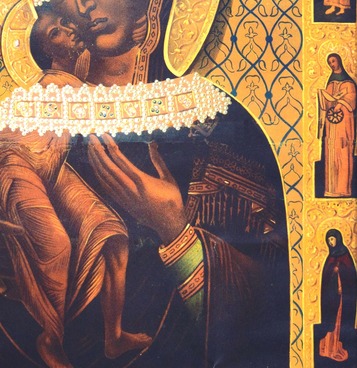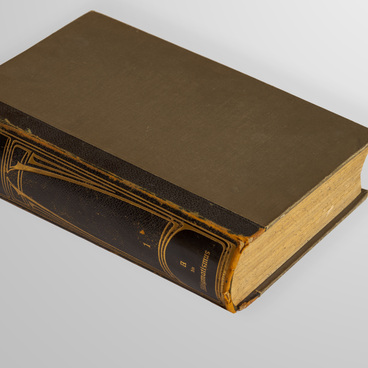The art collection of the Livadia Palace Museum includes the painting “Livadia Shore” by Boris Dmitriev. A little-known Russian artist, Boris Dmitriev left no visible trace in the history of landscape painting of the late 19th — early 20th centuries. Nevertheless, his canvas was part of the art collection of the imperial family and decorated the interiors of the palace buildings of the appanage estate on the Southern Coast of Crimea.
The canvas features the seashore in the area of Livadia. In the foreground there are high, foaming, turquoise-colored waves of the pre-storm sea crashing on the rocky shore. The background shows a narrow coastal strip that extends into a vegetation-covered steep slope with a few low residential buildings nestled at its foot. The bare top of the pyramidal rock can be seen in the background. To the left, in the lower corner, an inscription made by the creator of the painting: “I. Livadia. B. Dmitriev 91”.
The Crimean collection of paintings of the Romanov imperial family is notable for the variety of artists representing different levels of fame and skill but united by the theme of Livadia and the Southern Coast. Along with the original works of lesser-known and sometimes even quite unrecognized Crimean artists who were able to accurately convey the local colors familiar to them, the Livadia collection of the Imperial Family also included pieces by such outstanding painters as Academician and Professor of the Imperial Academy of Arts Ivan Aivazovsky, Luigi Premazzi, Rudolph von Alt, Mikhail Zichi, Bogdan Villewalde, Konstantin Filippov, Nikolay Krasovsky, Elena Samokysh-Sudkovskaya, and many others, including paintings by famous Italian painters. Special mention should be made of the work of the architect of the Livadia Palace, Academician of Architecture Nikolay Krasnov, who served as the Architect of the Imperial Court and whose duties included teaching painting to the Tsar’s children during their stay in Livadia. All the Grand Duchesses and the Tsesarevich enjoyed drawing, and in the palace there were many of their watercolor works. Grand Duchess Olga, the eldest daughter of Nicholas II, was especially gifted at painting.
The canvas features the seashore in the area of Livadia. In the foreground there are high, foaming, turquoise-colored waves of the pre-storm sea crashing on the rocky shore. The background shows a narrow coastal strip that extends into a vegetation-covered steep slope with a few low residential buildings nestled at its foot. The bare top of the pyramidal rock can be seen in the background. To the left, in the lower corner, an inscription made by the creator of the painting: “I. Livadia. B. Dmitriev 91”.
The Crimean collection of paintings of the Romanov imperial family is notable for the variety of artists representing different levels of fame and skill but united by the theme of Livadia and the Southern Coast. Along with the original works of lesser-known and sometimes even quite unrecognized Crimean artists who were able to accurately convey the local colors familiar to them, the Livadia collection of the Imperial Family also included pieces by such outstanding painters as Academician and Professor of the Imperial Academy of Arts Ivan Aivazovsky, Luigi Premazzi, Rudolph von Alt, Mikhail Zichi, Bogdan Villewalde, Konstantin Filippov, Nikolay Krasovsky, Elena Samokysh-Sudkovskaya, and many others, including paintings by famous Italian painters. Special mention should be made of the work of the architect of the Livadia Palace, Academician of Architecture Nikolay Krasnov, who served as the Architect of the Imperial Court and whose duties included teaching painting to the Tsar’s children during their stay in Livadia. All the Grand Duchesses and the Tsesarevich enjoyed drawing, and in the palace there were many of their watercolor works. Grand Duchess Olga, the eldest daughter of Nicholas II, was especially gifted at painting.



